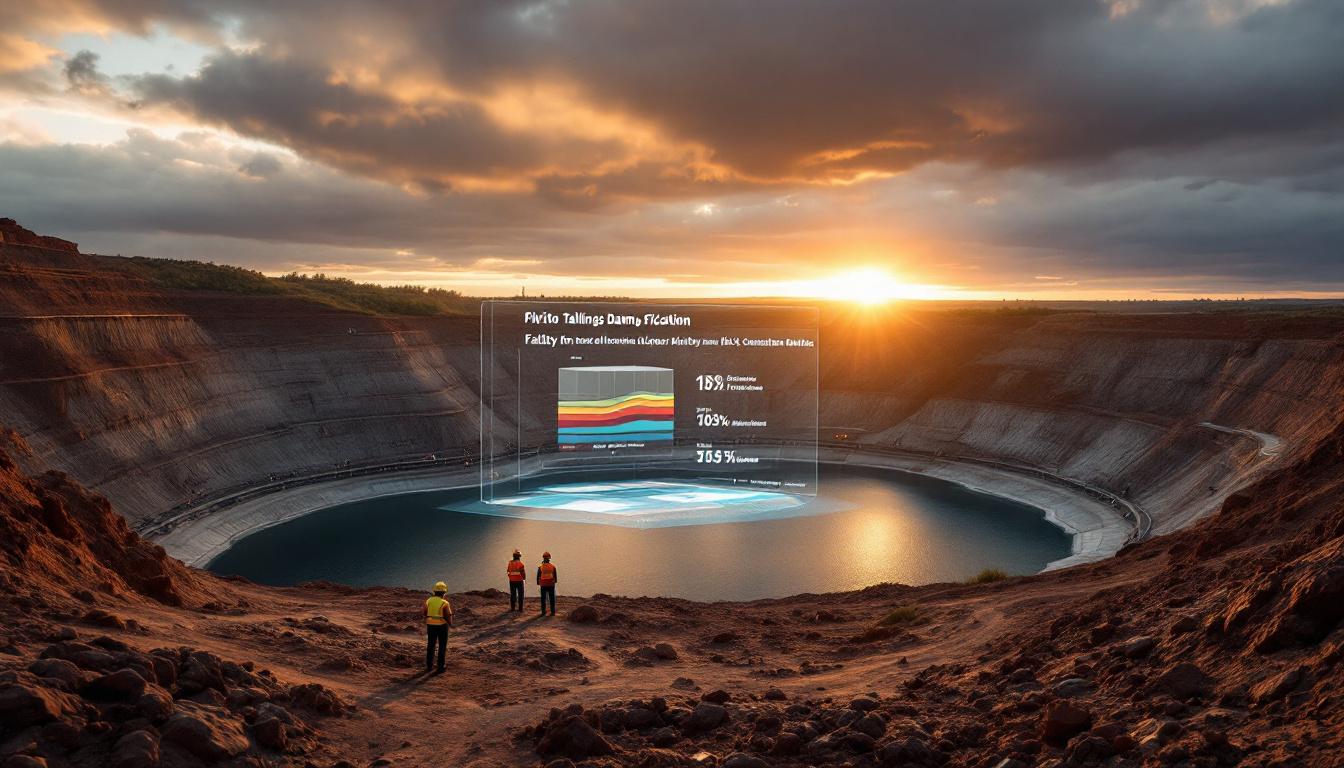What Happened to Rio Tinto's Iron Ore Shipments?
Rio Tinto, the world's largest iron ore producer, has reported a significant decline in shipments from its crucial Pilbara operations during the first quarter of 2025. The mining giant's shipments fell to 70.7 million metric tonnes (Mt), representing a 9% year-over-year decrease from the 78 Mt shipped during the same period in 2024.
The reported figure fell substantially short of market expectations, with analysts consensus from Visible Alpha projecting shipments of 73.6 Mt. This shortfall has raised concerns among investors and industry observers about the company's ability to meet its annual targets amid ongoing iron ore price surge.
First Quarter Shipment Decline
The substantial drop in iron ore shipments can be attributed to a series of disruptive weather events that hampered operations throughout the quarter. Rio Tinto's Pilbara operations, which account for approximately 90% of the company's global iron ore output, experienced multiple operational challenges due to these weather-related disruptions.
The company had previously warned stakeholders about potential losses totaling up to 13 million metric tons due to weather disruptions, and these forecasts have unfortunately materialized. The impact was particularly severe at Dampier port, where activities were significantly impaired by cyclonic conditions.
In comparison to previous years, the 2025 cyclone season has proven exceptionally challenging. Historical data shows that the 2024 Cyclone Ilsa disrupted shipments by approximately 5 Mt, whereas this year's multiple weather events have had a compounded negative effect on operations.
Impact of Tropical Cyclones
A succession of tropical cyclones swept through Western Australia's Pilbara region during the first quarter, forcing Rio Tinto to implement its comprehensive emergency protocols. These procedures include evacuating ports, securing equipment, and temporarily suspending operations to ensure worker safety and minimize infrastructure damage.
The company's 72-hour shutdown protocols for Category 3+ cyclones were activated multiple times throughout the quarter, significantly reducing operational capacity. These safety measures, while necessary, contributed substantially to the production shortfall.
"The cyclones snarled activities at Dampier port," according to Reuters reporting on the situation. The disruptions were not limited to port operations; they also affected the entire supply chain, including mining sites and rail transport networks that typically take 2-3 weeks to return to full capacity following severe weather events.
The Pilbara region, which supplies approximately 60% of global seaborne iron ore, is particularly vulnerable to seasonal weather patterns. Climate experts note that the 2025 cyclone season (December-April) has been intensified by La Niña weather patterns, creating more frequent and severe disruptions than originally anticipated in operational planning.
How Will This Affect Rio Tinto's 2025 Outlook?
Following the challenging first quarter, Rio Tinto has revised its production guidance, indicating that 2025 Pilbara shipments are now expected to be at the lower end of its previously announced guidance range. This adjustment reflects the significant operational challenges faced by the company and acknowledges the difficulty in fully recovering from the substantial production losses already incurred.
The company employs over 15,000 workers during peak operations in the Pilbara region, and these production challenges have ripple effects throughout the operational ecosystem. Recovery efforts are now focused on maximizing output during more favorable weather conditions in subsequent quarters.
Revised Production Guidance
Analysts are closely scrutinizing whether Rio Tinto's revised guidance fully accounts for potential additional weather disruptions, particularly given the unpredictable nature of climate patterns affecting the region. Questions remain about the company's ability to significantly accelerate production in later quarters to compensate for the first-quarter shortfall.
The financial impact of this guidance revision is substantial, potentially representing hundreds of millions in revenue loss at current market prices. This has prompted Rio Tinto to accelerate its investment in weather-resistant infrastructure and improved forecasting capabilities to better mitigate similar disruptions in future operational periods.
Recovery strategies will likely include increased mining automation technologies, extended operational hours during favorable weather windows, and optimized logistics to maximize throughput during the remainder of the year. Historical precedent suggests that recovery from similar disruptions typically extends well into subsequent quarters, as evidenced by the 2022 Cyclone Charlotte incident that caused an 8 Mt loss with full recovery only achieved by Q3.
Comparison with Industry Peers
Vale, Rio Tinto's major competitor in the global iron ore market, has also experienced production challenges, reporting a 4.5% decline in iron ore output for the same period. However, Vale has maintained its forecast to produce between 325-335 million tons of iron ore in 2025, suggesting potentially different recovery capabilities or more favorable operating conditions in its production regions.
This divergence in outlook between the two major producers highlights the localized nature of production challenges in the global iron ore market. While both companies face similar market conditions, their operational resilience and recovery capabilities appear to differ significantly.
Industry analysts note that BHP, another major player in the iron ore market, implemented an effective rebound strategy following similar disruptions in 2024, heavily leveraging increased automation and operational flexibility. Rio Tinto may look to adopt similar approaches as it works to recover from the first-quarter shortfall.
What Are the Broader Market Implications?
The production challenges faced by Rio Tinto and other major iron ore producers have significant implications for global markets, particularly given the critical role that Australian production plays in worldwide supply chains. With the Pilbara region supplying approximately 60% of global seaborne iron ore, disruptions in this area have outsized effects on global availability and pricing.
The combined production shortfalls from Rio Tinto and Vale have reinforced supply tightness in benchmark pricing, with steel industry analysts warning of potential price floors around $150 per tonne if major producers continue to underdeliver against expectations.
Impact on Global Iron Ore Supply
The global steel production growth rate, currently at approximately 3.5% year-over-year according to the World Steel Association's 2025 projections, creates sustained demand for iron ore. This growth in demand coincides with supply constraints, creating potential market imbalances.
Iron ore inventory levels at Chinese ports have dropped to approximately 95 Mt from pre-cyclone levels of around 110 Mt, indicating diminishing buffers against supply disruptions. This reduction in available inventory could amplify price volatility if production challenges persist.
Historical precedent from 2023, when Australian rail strikes triggered price spikes to $180 per tonne, demonstrates the market's sensitivity to supply disruptions from major producing regions. The current situation presents similar conditions for potential price volatility, requiring careful strategies for navigating iron ore volatility.
Interestingly, China's iron ore imports and gradual shift toward increased scrap steel utilization (currently representing approximately 22% of 2025 output) may provide some counterbalance by reducing dependency on iron ore imports. However, this transition is not occurring rapidly enough to offset immediate supply constraints.
Market Response to Production Challenges
Investors and market analysts are carefully monitoring recovery efforts at Rio Tinto's operations, with particular attention to the company's ability to accelerate production in subsequent quarters. The production shortfall has already influenced market sentiment, with futures contracts reflecting expectations of tighter supply.
Supply constraints from major producers could have continuing ripple effects throughout the steel industry, potentially affecting construction and manufacturing sectors that rely heavily on steel inputs. Infrastructure projects in emerging economies remain particularly vulnerable to steel price volatility resulting from iron ore supply constraints.
The current market dynamics highlight the ongoing tension between growing global demand for steel products and the vulnerability of key supply regions to climate-related disruptions. This tension underscores the importance of diversification in supply sources and continued investment in operational resilience within Australia's mining sector trends.
FAQ About Rio Tinto's Iron Ore Operations
How significant is the Pilbara region to Rio Tinto's iron ore business?
The Pilbara region in Western Australia represents the cornerstone of Rio Tinto's iron ore operations, contributing approximately 90% of the company's global iron ore production. This region is home to 16 mines, four independent port terminals, and a 1,700-kilometer rail network that forms an integrated production system. The Pilbara's high-grade iron ore deposits are particularly valued in international markets for their quality and consistency.
What measures does Rio Tinto take to prepare for cyclone season?
Rio Tinto implements comprehensive cyclone preparation protocols that begin months before the official cyclone season (December-April). These include securing equipment, reinforcing critical infrastructure, establishing evacuation routes, and training personnel in emergency procedures. The company utilizes advanced weather monitoring systems, including Doppler radar networks, to track developing storms and implements a tiered response system based on cyclone severity.
When a cyclone approaches, Rio Tinto activates its 72-hour shutdown protocols for Category 3+ cyclones, which include evacuating non-essential personnel, securing or relocating movable equipment, and implementing protective measures for fixed infrastructure. These preparations represent a significant annual investment but are essential for protecting both personnel and assets.
How often do cyclones impact mining operations in the Pilbara?
The Pilbara region typically experiences 4-6 cyclones during the Australian summer months (December to April), though the number and intensity can vary significantly from year to year. Climate patterns such as La Niña can increase both the frequency and severity of cyclonic activity in the region.
Not all cyclones directly impact mining operations, but those that cross near operational areas can cause disruptions lasting from several days to several weeks. In recent years, climate change factors have contributed to increasing unpredictability in cyclone patterns, making operational planning more challenging for mining companies operating in the region.
What are the long-term strategies for mitigating weather-related disruptions?
Mining companies like Rio Tinto are implementing multi-faceted approaches to increase operational resilience against weather-related disruptions. These strategies include:
- Investing in hardened infrastructure designed to withstand extreme weather events, including reinforced port facilities and protected rail infrastructure
- Deploying advanced weather prediction technologies to improve forecasting accuracy and extend warning times
- Increasing automation and remote operations capabilities to reduce evacuation requirements and enable faster operational recovery
- Developing more flexible supply chain models with built-in redundancy to maintain partial operational capacity during weather events
- Establishing strategic inventory buffers at key distribution points to minimize customer impacts during production disruptions
- Researching and implementing climate adaptation measures based on long-term climate change projections specific to the Pilbara region
Additionally, companies are increasingly incorporating climate resilience metrics into their infrastructure development plans, conducting detailed cost-benefit analyses that factor in the increasing frequency of extreme weather events when evaluating capital investments.
Ready to Stay Ahead of Major Mineral Discoveries?
Don't miss out on the next big market mover like the ones that follow significant mineral discoveries. Visit Discovery Alert's discoveries page to see how their proprietary Discovery IQ model provides real-time alerts on ASX announcements, giving you the market advantage that serious investors need.




